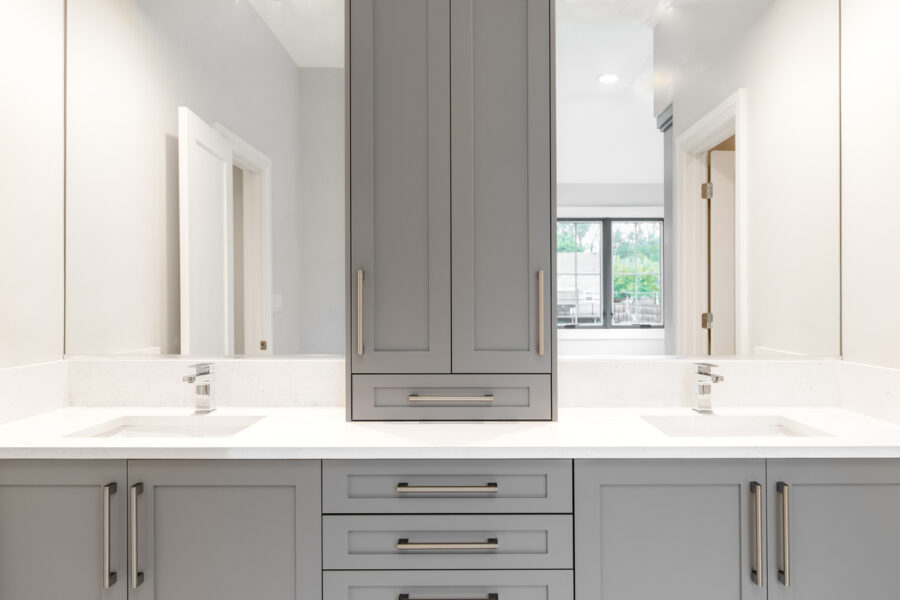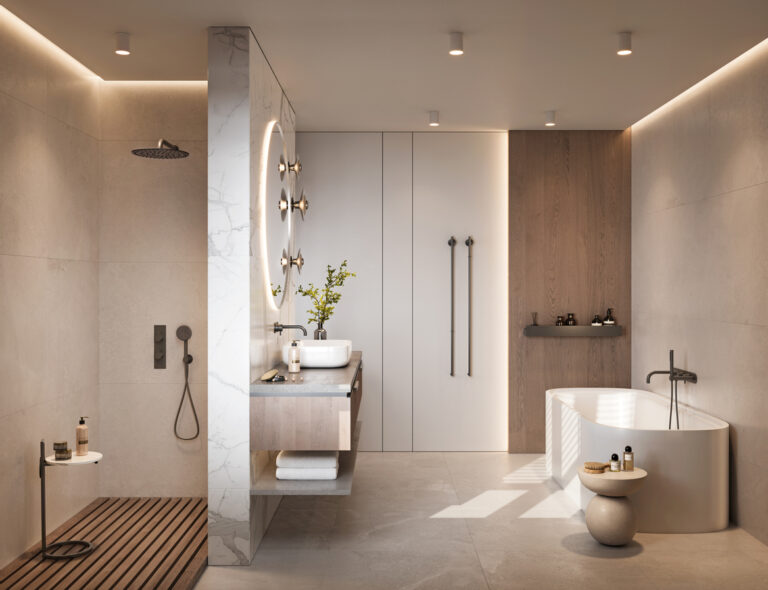The most important room in the house after the kitchen, renovating or updating a bathroom involves a multitude of decisions.
Should you have porcelain, stone or cement flooring? Should you go for a neutral or flamboyant colour scheme? Is it worth investing in a vanity? What is the best lighting arrangement? What’s better, chrome or brass fixtures? How can you prevent mould and mildew? And, is shower glass instead of a curtain worth the price?
The answer to the last question is a resounding “yes” according to Jennifer Dearing, Senior Interior Designer at Hamma Galleries. “It’s an expensive touch, but it really opens up the bathroom. It makes everything lighter and brighter.”
Ms. Dearing has extensive experience helping her clients make the most of their bathroom spaces and, she explained, the most successful renovations all include “good space planning, storage, and material selections which reflect the personal style of the client, but remain classic enough to give the bathroom longevity.”
STYLE LONGEVITY
A bathroom is not only crucial for its user’s day-to-day comfort and happiness but, done well, it will also increase the resale value of your home. Upgrades however, can be costly, so longevity is always a priority in Ms Dearing’s designs.
“Most clients renovate their bathrooms every 20 – 30 years, so your selections now should last the test of time,” she emphasized, recommending “noble materials” such as natural stones, as well as chrome finishes and white fixtures.
“Brass or black fixtures may be trendy now, but not so much in 20 years,” she said. “I think everyone remembers the avocado or harvest gold bathrooms, which had toilets and tubs to match. Everyone couldn’t wait to get rid of them once the trend had passed. The bathrooms themselves may have been in great condition, but the style had long past its timeline!”
Her ideal bathroom would have classic tile choices in a white or cream ceramic or natural stone and “a touch of wood either in the vanity, or accessories to warm it up and keep it from being too sterile.”
An ideal ceramic tile choice is the subway tile. “Subway tiles never go out of style. They’ve been used in subways for a hundred years and they’ve been used in classy bathrooms for the same amount of time.”
A “fun floor,” she added can add personality to a bathroom, particularly patterns such as marble basket weaves or patterned cement tiles. This can be a great way to incorporate colour, while maintaining a classic look.
“I generally recommend thinking of hotel bathrooms,” she said. “Whether traditional or modern, they are usually neutral as it is not sustainable to have to remodel 400+ bathrooms every few years.”
WATERPROOFING
Being able to dry out your bathroom easily and prevent leaks, as well as mould and mildew from appearing, is vital. For this, Ms Dearing recommended using a good waterproof membrane between the walls and tile, an epoxy-based grout, and an extractor fan.
For the waterproof membrane, her product of choice is Kerdi by Schluter. This is a sheet system, which, if your shower is against an outside wall, prevents moisture coming in as well as water from your shower leaking out.
Epoxy based grout, she continued, is “indicated to inhibit the growth of mildew.” Regardless of the grout type you choose however, she advised having it sealed and then cleaned with “gentle cleansers to maintain its protective qualities,” adding that “most people think cleaning with bleach is the best, but it actually eats away at the sealer, leaving the grout porous and vulnerable to mould.” Sealers should be reapplied every few years, ideally by a professional.
Finally, she advised investing in a good extractor or heat light vent system, “to remove excess moisture or humidity quickly after a shower or hot bath.” Where budget allows, towel warmers or, if you want to go all out, under-floor heating, will also help keep your bathroom dry.
 SPACE, STORAGE, ECONOMY
SPACE, STORAGE, ECONOMY
When it comes to small bathrooms, the layout is particularly crucial to maximise the space. “You want to have vanity first, toilet next, tub or shower right at the very end,” she said. If you have two bathrooms, she recommended a shower in one and a tub in the other. For resale value, it is worth having at least one bathtub in your home.
The current trend however, particularly in newer build homes, is for bigger bathrooms with freestanding tubs. Unless you really need it, though, she warned against these tubs as “it takes a whole lot of water to fill. It will drain most people’s average size hot water heater.”
Another economy she suggested is to only tile the bathtub or shower, leaving the rest of the room painted. “Nowadays we have really good paints,” she said. “You can wipe it all down and it saves you a lot of money in tile, or stone, and the installation of it.”
In addition to adding warmth and interest, a vanity will also give you storage. To maximise that storage potential, Ms Dearing recommended using a “bottle style drain trap” underneath your sink, instead of the larger siphon or ‘U’ trap. This gives you more space within your vanity and you can have an extra drawer ‘cut’ around the smaller trap.
LIGHTING
Lastly, but crucial to the success of your bathroom design, is lighting. For the general overhead lighting, she recommended recessed lighting, including wet location rated lighting for the bathing area, and an extractor fan, heat and light unit.
Decorative lighting such as stylish sconces either side of the vanity, at face height, are ideal for both fun and function: “For doing make up and things like that, you want the light at either side of your face and almost in front of it. That lights up your face well,” she said. “If you only have overhead lighting, it casts shadows. It doesn’t allow you to see you face properly and get all the hairs,” she laughed.

